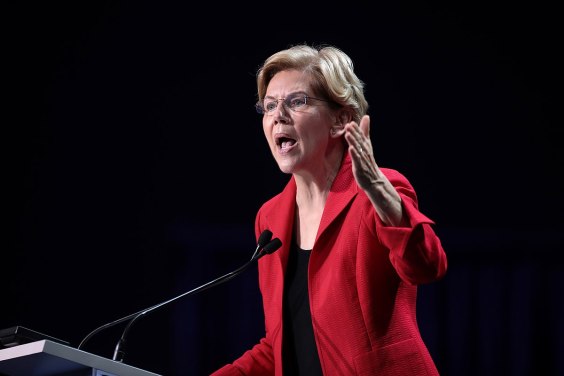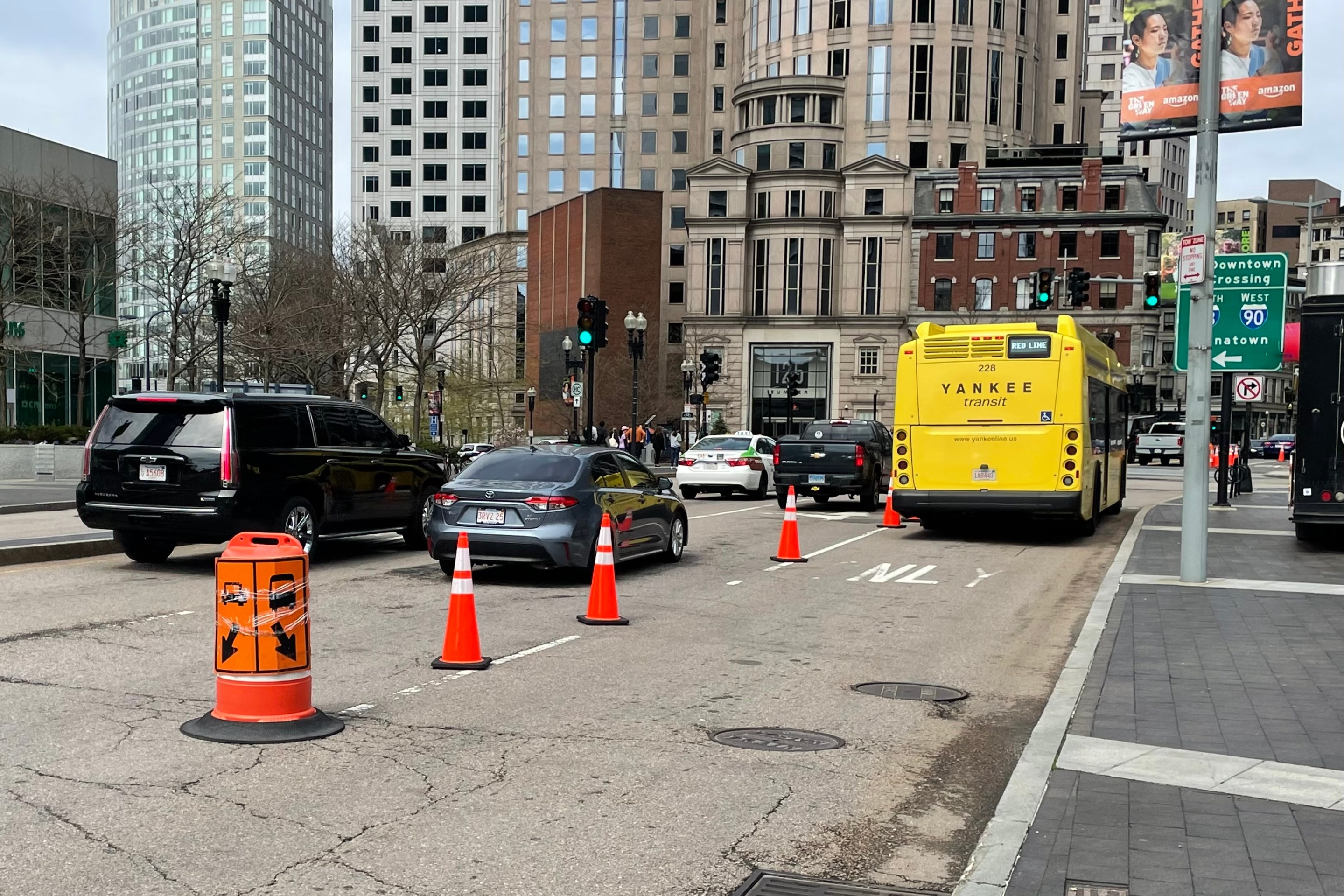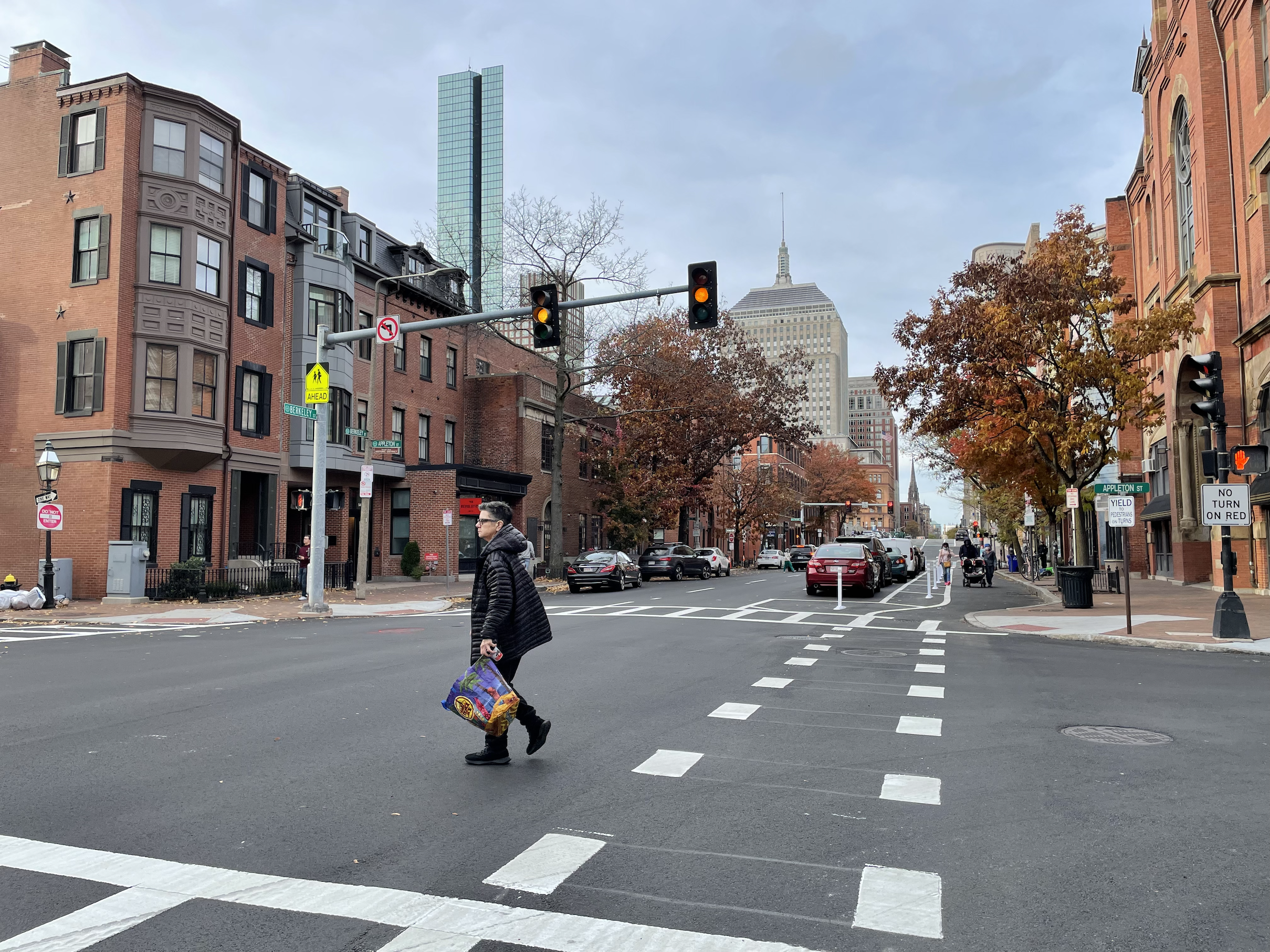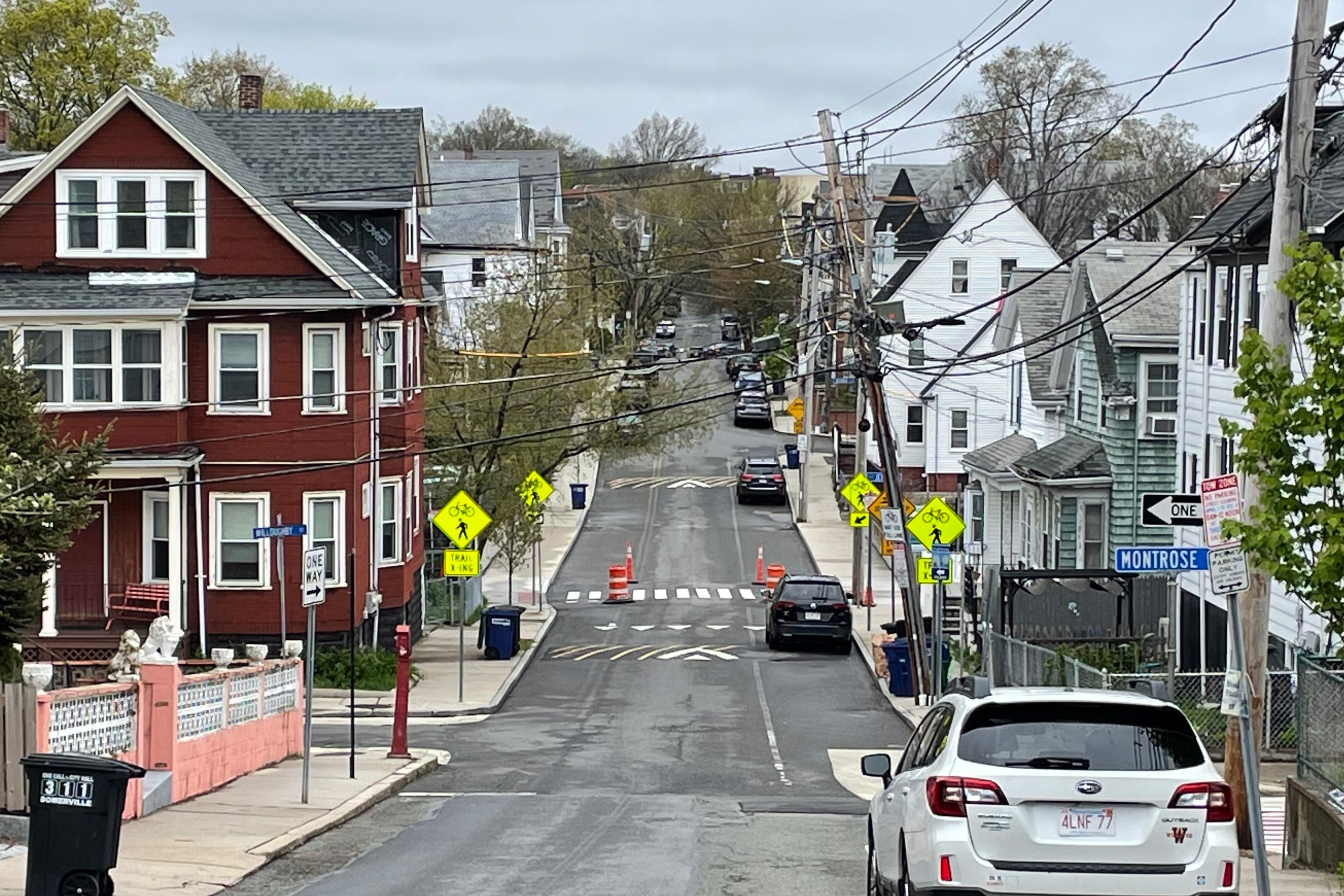The T’s ‘Fare Transformation’ Project Is Transforming Into A Boondoggle
9:30 PM EDT on March 28, 2023
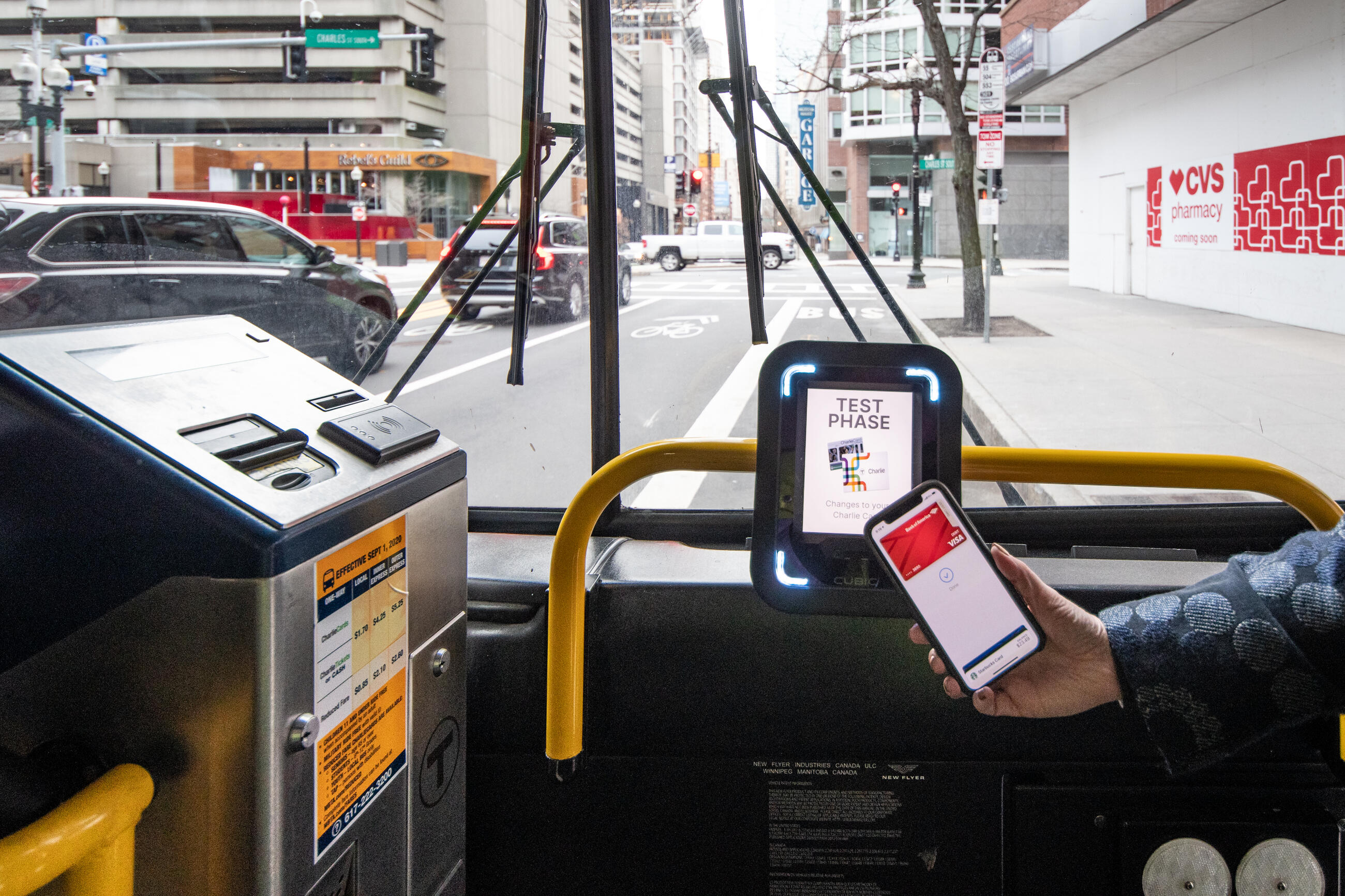
A bus rider pays their fare with their phone during a test of the T’s new fare system on an MBTA bus in downtown Boston in January 2021. Courtesy of the MBTA.
Since 2018, the MBTA has been under contract to replace the CharlieCard and introduce a new fare payment system for the region's transit systems.
But the project is far behind schedule, in spite of a 30 percent budget increase that MBTA officials approved in 2020.
Now, as the T struggles with a severe shortage of workers and serious safety issues, advocates and even some high-ranking T officials are raising questions about whether a new fare system is really worth all the money and the effort it would require.
"Why are they still trying to move forward with this when the whole system is under slow zones and these safety issues are screaming out?" wonders Mela Bush-Miles, the Transit-Oriented Development Director at Alternatives for Community & Environment (ACE) in Roxbury. "There are a thousand things that need to fixed and the fare collection system is not one of them."
"These transformation initiatives really hinge on the agency’s ability to provide basic service and addressing its workforce shortage," Julia Wallerce, Boston's program manager for the Institute for Transportation and Development Policy, told StreetsblogMASS. "We've been talking about 'Fare Transformation' for years now; it’s unfortunate that such a large contract was signed and hasn’t delivered anything for riders."
"A thorough review of all options"
When the T's board of directors renewed its Fare Transformation contract with Cubic, a private-sector transportation and military contractor, with a higher budget in 2020, several of the new system's purported benefits – like the ability to pay fares with a smartphone, and all-door boarding for buses and Green Line trains with the installation of new tap-to-pay fare readers like the one pictured above – were expected to start rolling out in 2022.
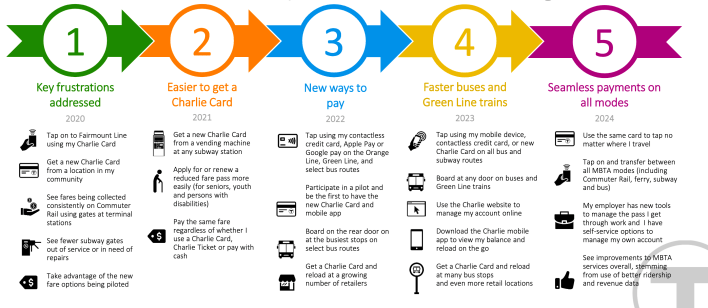
Now, those new initiatives are on hold, and their schedule is uncertain. The MBTA's governing board hasn't had an update on the effort since 2021.
"The Healey-Driscoll Administration has undergone a preliminary review of this complex project to assess its current status and timeline for completion," MBTA spokesperson Lisa Battiston told StreetsblogMASS. "It is unlikely to meet the current 2024 timeline for full implementation."
Battiston added that "the new Administration is doing a thorough review of all options at this time, but we are continuing with the project as planned."
The T has spent relatively little on its contract with Cubic so far: Battiston said that the T has been contractually obligated to pay Cubic $17.5 million in "milestone payments" to date.
That represents about 3 percent of the 2020 contract's $597.5 million budget for one-time capital costs.
The contract also included an additional $337.9 million for Cubic to operate and administer the new fare system for 10 years. But because there's still no new fare system to operate, the T hasn't spent any of those operating funds so far.
The T's struggle to hire enough workers is another big obstacle for the project. If the new fare system is implemented, the T would need to hire dozens of civilian fare inspectors to conduct spot-checks for proof of payment from riders on buses and the Green Line.
But the T already has over 1,000 vacant positions – many of them in safety-critical departments – that its human resources department needs to fill.
During a budget presentation at last week's MBTA board meeting, MBTA Chief Financial Officer Mary Ann O'Hara asked board members to consider a "safety focused investment" scenario for the 2024 budget – a scenario in which the Fare Transformation initiative would be postponed "pending ridership return and growth."
Loose change, slower buses
The delays that have plagued the Fare Transformation initiative have also delayed the benefits that the new fare system was supposed to deliver to riders.
One of the biggest advantages of the new system was supposed to be a new tap-to-pay fare verification system, which could have sped up buses by ending cash transactions and allowing riders to board vehicles through the front or back doors in a bus or Green Line train.
"All-door boarding can actually speed up the bus travel times more than even dedicated bus lanes because of its ability to reduce dwell times - the time that buses wait at bus stops," says Julia Wallerce of ITDP. "That dwell time can be cut in half with both doors open. You have a much more comfortable, speedy bus experience that’s much more like rapid transit. It’s also much easier for drivers if they don’t have to manage fare collection."
The T’s hiatus from fare collection during the height of the pandemic in 2021 offered the agency some real-world data on how much time buses could save with all-door boarding.
Based on that experience, MBTA staff estimated that all-door boarding could reduce the duration of the average bus round-trip by 4 percent – in other words, if a bus today typically takes 100 minutes to drive from one end of its route to the other and back again, that same trip might only take 96 minutes with all-door boarding.
Multiplying that time savings across every bus trip, every day, for every route, would add up to about $29 million a year in reduced operating and vehicle replacement costs for the T.
Wallerce also notes that the new fare system would have integrated payments for multiple transit modes - commuter rail, bus, and ferries – that currently use different payment systems.
Fare transformation vs. fare elimination
The T has made some small improvements to its fare systems since the onset of the pandemic. In 2022, it installed new fare vending machines at every rapid transit station to make it considerably easier for riders to get CharlieCards, which had previously only been available at a handful of locations.
But the most headline-grabbing fare policies in recent years have involved getting rid of them altogether.
Using pandemic relief funding, the City of Boston has been paying the T to suspend fare collections on its 28 bus route – the busiest bus route in New England – since the summer of 2021.
In 2022, the city expanded the program to cover two additional bus routes, plus all paratransit trips in Dorchester, Roxbury, and Mattapan.
A recent evaluation of the program from the City of Boston found that most of the riders using the fare-free buses are residents who are low-income, people of color, seniors, people with disabilities, or who live in households with few or no vehicles, and that a significant number of these routes' riders are "using their savings to purchase food, save towards long-term goals and build emergency funds."
Before the pandemic began, fare revenues paid for about one-third of the MBTA's annual operating budget.
Since 2020, though, the agency has become significantly less reliant on fares: they covered only one-fifth of the agency's budget in 2023.
As more white-collar workers forego their daily commute, lower-income riders are paying a higher proportion of the revenues that the T does collect, making the overall fare structure more regressive than it was before the pandemic.
Fare-free buses are also able to offer many of the same operational benefits, like all-door boarding, that the new fare system was supposed to deliver.
The City of Boston is paying the T about $8 million over two years to compensate the agency for the revenues it expects to lose on its fare-free pilot in Dorchester and Mattapan.
Fare-free advocates argue that, given the T's reduced reliance on fares, and the relatively low proportion of revenue that it collects from bus-only trips, the costs of eliminating fares on all of its bus routes might not be that much higher than the cost of hiring dozens of fare inspectors, installing new fare readers on a thousand buses, and maintaining new fare vending machines at hundreds of bus stops.
"The price tag of collecting fares is the outrageous part of this," says Mela Bush-Miles of ACE. "Why would you spend $1 billion to collect $1.70 from riders? And then you'd need to hire fare inspectors to police that. Boston's free bus pilot shows us, well, if you didn’t collect fares, you could speed up the buses, people wouldn’t be targeted for fare evasion, you wouldn’t have to buy all those fare vending machines."
Read More:
Stay in touch
Sign up for our free newsletter

